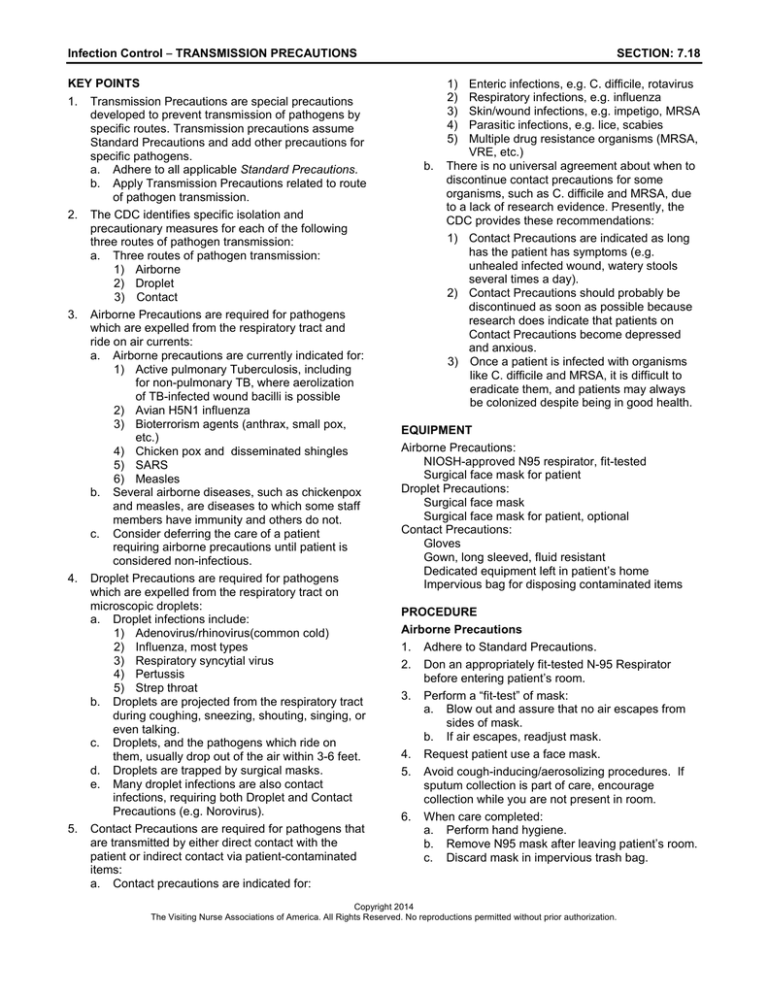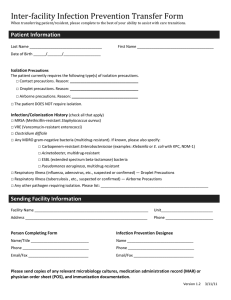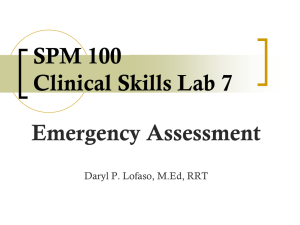
Infection Control – TRANSMISSION PRECAUTIONS
KEY POINTS
1. Transmission Precautions are special precautions
developed to prevent transmission of pathogens by
specific routes. Transmission precautions assume
Standard Precautions and add other precautions for
specific pathogens.
a. Adhere to all applicable Standard Precautions.
b. Apply Transmission Precautions related to route
of pathogen transmission.
2. The CDC identifies specific isolation and
precautionary measures for each of the following
three routes of pathogen transmission:
a. Three routes of pathogen transmission:
1) Airborne
2) Droplet
3) Contact
3. Airborne Precautions are required for pathogens
which are expelled from the respiratory tract and
ride on air currents:
a. Airborne precautions are currently indicated for:
1) Active pulmonary Tuberculosis, including
for non-pulmonary TB, where aerolization
of TB-infected wound bacilli is possible
2) Avian H5N1 influenza
3) Bioterrorism agents (anthrax, small pox,
etc.)
4) Chicken pox and disseminated shingles
5) SARS
6) Measles
b. Several airborne diseases, such as chickenpox
and measles, are diseases to which some staff
members have immunity and others do not.
c. Consider deferring the care of a patient
requiring airborne precautions until patient is
considered non-infectious.
4. Droplet Precautions are required for pathogens
which are expelled from the respiratory tract on
microscopic droplets:
a. Droplet infections include:
1) Adenovirus/rhinovirus(common cold)
2) Influenza, most types
3) Respiratory syncytial virus
4) Pertussis
5) Strep throat
b. Droplets are projected from the respiratory tract
during coughing, sneezing, shouting, singing, or
even talking.
c. Droplets, and the pathogens which ride on
them, usually drop out of the air within 3-6 feet.
d. Droplets are trapped by surgical masks.
e. Many droplet infections are also contact
infections, requiring both Droplet and Contact
Precautions (e.g. Norovirus).
5. Contact Precautions are required for pathogens that
are transmitted by either direct contact with the
patient or indirect contact via patient-contaminated
items:
a. Contact precautions are indicated for:
SECTION: 7.18
1)
2)
3)
4)
5)
b.
Enteric infections, e.g. C. difficile, rotavirus
Respiratory infections, e.g. influenza
Skin/wound infections, e.g. impetigo, MRSA
Parasitic infections, e.g. lice, scabies
Multiple drug resistance organisms (MRSA,
VRE, etc.)
There is no universal agreement about when to
discontinue contact precautions for some
organisms, such as C. difficile and MRSA, due
to a lack of research evidence. Presently, the
CDC provides these recommendations:
1) Contact Precautions are indicated as long
has the patient has symptoms (e.g.
unhealed infected wound, watery stools
several times a day).
2) Contact Precautions should probably be
discontinued as soon as possible because
research does indicate that patients on
Contact Precautions become depressed
and anxious.
3) Once a patient is infected with organisms
like C. difficile and MRSA, it is difficult to
eradicate them, and patients may always
be colonized despite being in good health.
EQUIPMENT
Airborne Precautions:
NIOSH-approved N95 respirator, fit-tested
Surgical face mask for patient
Droplet Precautions:
Surgical face mask
Surgical face mask for patient, optional
Contact Precautions:
Gloves
Gown, long sleeved, fluid resistant
Dedicated equipment left in patient’s home
Impervious bag for disposing contaminated items
PROCEDURE
Airborne Precautions
1. Adhere to Standard Precautions.
2. Don an appropriately fit-tested N-95 Respirator
before entering patient’s room.
3. Perform a “fit-test” of mask:
a. Blow out and assure that no air escapes from
sides of mask.
b. If air escapes, readjust mask.
4. Request patient use a face mask.
5. Avoid cough-inducing/aerosolizing procedures. If
sputum collection is part of care, encourage
collection while you are not present in room.
6. When care completed:
a. Perform hand hygiene.
b. Remove N95 mask after leaving patient’s room.
c. Discard mask in impervious trash bag.
Copyright 2014
The Visiting Nurse Associations of America. All Rights Reserved. No reproductions permitted without prior authorization.
Infection Control – TRANSMISSION PRECAUTIONS
Droplet Precautions
1. Adhere to Standard Precautions.
2. Don surgical mask on entering patient’s room.
3. Ask patient to don a surgical mask, if tolerated.
4. When not providing direct care, avoid being within 3
feet of patient.
5. When care completed:
a. Perform hand hygiene and remove surgical
mask.
b. Discard in impervious trash bag. Close bag.
Contact Precautions
1. Obtain equipment needed for patient care that can
be dedicated to patient and left in home.
2. Limit equipment brought into home:
a. Plan ahead to bring as little as possible into the
home.
b. Consider leaving documentation devices/forms
in car, documenting in car instead of home.
c. Remove supplies needed for visit from visit bag.
Do not bring visit bag into home.
d. Place needed supplies in a “hip pack” or a
plastic bag.
e. Include a clean plastic bag for removing items
from home.
3. Don gown and gloves for all patient contact,
including contact with intact skin and items in
patient’s environment.
4. Provide education about infection control strategies
in patient’s home:
a. Hand hygiene
b. Appropriate disinfectants
c. Need for cleaning items frequently touched by
patient and others in home (light switches, door
knobs, etc.)
d. Other topics as appropriate to infection
5. When care completed:
a. If equipment cannot remain in home, clean and
disinfect.
b. Place them in a clean plastic bag for
transporting out of home.
c. Remove gloves.
d. Remove gown.
e. Perform hand hygiene.
6. Discard used supplies in an impervious trash bag.
SECTION: 7.18
REFERENCES
CDC. (2007). Guideline for isolation precautions:
Preventing transmission of infectious agents in
healthcare settings. Retrieved from
http://www.cdc.gov/hicpac/2007IP/2007isolationPre
cautions.html
CDC. (2005). Guidelines for preventing the transmission
of mycobacterium tuberculosis in health-care
settings. Morbidity and Mortality Weekly Report
Recommendations, 54, RR-17. Retrieved from
http://www.cdc.gov/mmwr/PDF/rr/rr5417.pdf
Healthcare Infection Control Practices Advisory
Committee. (2006). Management of multidrugresistant organisms in healthcare settings.
Retrieved from:
http://www.cdc.gov/hicpac/mdro/mdro_toc.html
Kenneley, I. (2012). Infection control in home
healthcare: An exploratory study of issues for
patients and providers. Home Healthcare Nurse
30(4), 235-45.
Occupational Health and Safety Administration. (n.d.).
Tuberculosis. Retrieved from
http://www.osha.gov/SLTC/tuberculosis/index.html
Rhinehart E., & McGoldrick ,M..M. (2006). Infection control
in home care and hospice. Sudbury, MA: Jones and
Bartlett.
AFTER CARE
1. If supplies taken out of home need additional
cleaning/disinfecting, transport to designated area in
impervious bag.
2. Document in the patient’s record:
a. Type of precautions used to provide care
b. Any education provided to patient/caregiver
about infection control
Copyright 2014
The Visiting Nurse Associations of America. All Rights Reserved. No reproductions permitted without prior authorization.



